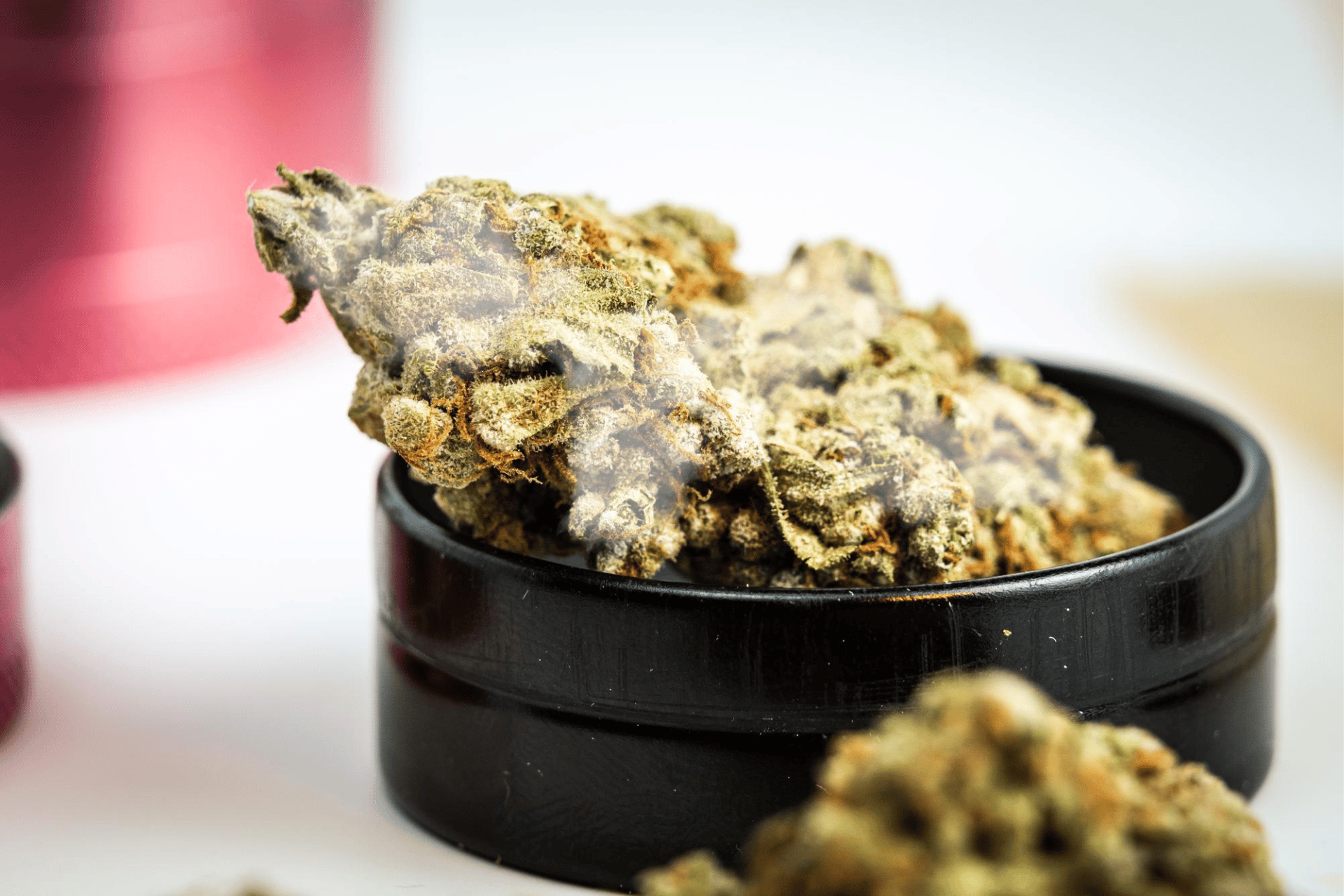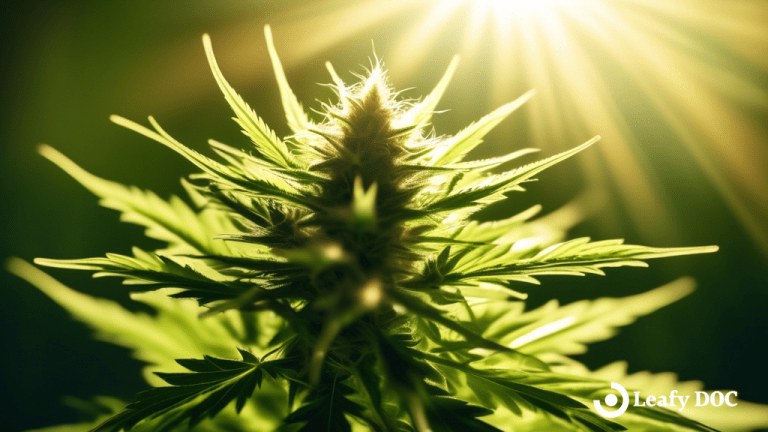What to Know About Moldy Weed
by Haley Mills · February 1, 2023
Moldy weed may not seem like a big deal, but it can actually be pretty dangerous. Here’s what you need to know about mold and your weed.

Since medical marijuana legalization has gained popularity over the past few years, there have been a few cannabis plant recalls in recent years in states like Colorado, California, Michigan, and Florida due to potential health hazards from consuming moldy cannabis flowers.
Cannabis plants can start to grow mold in the growing, drying, or curing stages. Marijuana becomes highly susceptible to decay when the environment is unstable, so it’s critical to maintain properly controlled humidity and air ventilation.
Excess moisture is dangerous when it comes to the risk of weed mold. As a medicinal cannabis consumer, it’s essential to be aware of the potential issues and be able to identify and prevent moldy weed.
The Basics of Cannabis Mold
Mold is unsuitable for anyone’s immune system, but it may worsen in some individuals. Approximately one-fourth of the human population carries a particular gene that makes them more susceptible to developing mold-related illnesses.
Others who may be at increased risk for a harmful reaction if they use moldy weed include those with asthma, respiratory conditions, autoimmune disorders, chemical sensitivities, and other chronic medical conditions.
Different Types of Weed Mold
The seven types of mold that grow on cannabis plants are:
- Aspergillus
- Botrytis (Grey Mold)
- Mucor
- Cladosporium
- Rhizopus
- Penicillium
- Powdery Mold
Is marijuana mold common?
Bud rot and mold are relatively common, especially with beginner growers and home cultivators, due to insufficient ventilation and an excess of moisture. Mold is a fungus that thrives in moist, humid environments with little adequate air ventilation. It reproduces through microscopic airborne spores.
Humans typically inhale or ingest tiny amounts of mold spores daily, which are not harmful to a healthy immune system. Once cannabis contains mold spores, it is challenging to get rid of them. They can survive combustion when heated and even the decarb process in an oven, but you will lose THC and only be able to make edibles or tinctures with the buds. It’s best to discard the cannabis rather than smoke moldy weed.
Tips for Identifying Moldy Cannabis
Here are some tips for identifying the top six types of cannabis fungal infection to avoid the health consequences of consuming moldy marijuana.
Bud Rot
Bud rot typically begins with fluffy white growth in the middle or on the sides of the flowers. Botrytis can be seen with the naked eye as the color changes and becomes a dry texture.
Powdery Mildew
In the earlier stages of powdery mildew, you can see small circles of white mold on the tops of stems and leaves. The fungi will become denser as it progresses, covering the buds in thick white powder.
Fusarium
Dark spots will quickly turn the lower leaves a yellowish-brown color. Visual signs to look out for are leaves that have wilted but not entirely fallen off and limp stems.
Aspergillus
Aspergillus is a common mold found both indoors and outside. Its spores, usually dark green or black, can appear in soil or on cannabis buds. While we’re exposed to small amounts of these spores regularly with little risk, the danger increases when moldy cannabis is smoked or inhaled.
Certain strains of Aspergillus can cause severe infections, particularly in the lungs, and may even affect the central nervous system. This is especially true for people with compromised immune systems or existing respiratory conditions. Inhaling these spores directly through cannabis smoke delivers them in high concentrations—making the risk far greater than from normal environmental exposure.
To stay safe, always avoid smoking weed that looks, smells, or feels moldy.
Penicillium
Penicillium mold is predominantly found indoors. Its spores are typically light blueish-green and can ruin crops and harm humans and animals that have been inhaling mold.
Rhizopus
It produces a grayish-white coating on its spores and may infect humans with certain health conditions, such as when a person has a compromised immune system.
How Mold Affects the Flavor and Aroma of Cannabis
Moldy cannabis is easy to detect through its unpleasant scent. Instead of the usual earthy, citrusy, or pine-forward aromas that come from healthy terpene profiles, like those in strains such as Lemon Haze or Jack Herer, you’ll notice a musty smell, similar to wet cardboard or a damp basement.
The taste is just as disappointing. Smoking moldy weed often results in a harsh, bitter, and acrid flavor that completely overpowers the expected smoothness. For many users, the off-putting flavor alone is enough to stop smoking. Mold doesn’t just alter the sensory experience; it ruins it, stripping away the qualities that make cannabis enjoyable.
What Are Aflatoxins and Why Do They Matter?
Aflatoxins are toxic compounds produced by molds like Aspergillus flavus and Aspergillus parasiticus. While they’re more common in crops like peanuts or corn, they can occasionally contaminate cannabis, especially when it’s improperly stored or grown in humid conditions.
If inhaled or ingested through moldy weed, aflatoxins may pose serious health risks. Long-term exposure has been linked to liver damage and even liver or lung cancer. Organizations like the WHO and CDC classify aflatoxins as potent carcinogens. This underscores the importance of using mold-free cannabis and following safe storage practices.
Potential Risks
While smoking moldy weed may not kill you, it is still not recommended and could have potential adverse effects, especially for those with certain chronic conditions.
If you consume moldy weed and are allergic, you could potentially experience the following mild effects:
- coughing
- nausea and vomiting
You could also end up with inflammation of your sinuses and lungs, with more severe symptoms like:
- sinus pain
- drainage
- congestion
- wheezing
- chest pain
Inhaling certain mold species can have severe health consequences for those with weakened immune systems or lung conditions. Some molds like Aspergillus, Mucor, and Cryptococcus can cause severe infections in the lungs, central nervous system, and brain for people with a medical condition related to the immune system.
Avoiding Moldy Cannabis
- Buds should be appropriately stored in a cool, dry place but try not to refrigerate or freeze them. The ideal temperature is just under 77°F.
- Remember to keep your weed in airtight containers, preferably with darker-colored glass. Weed does have an expiration date of approximately six months to one year.
- The ideal humidity level in your storage containers should be between 59% to 63%. You can purchase disposable humidity packs at many dispensaries that can be placed inside your mason jar.
- Less airflow can lead to mold, so ensure proper ventilation in the storage room.
- Moldy weed will have a distinct odor. Cannabis products infected by mold will usually smell musty after closer examination. Exposing cannabis to a black light is an excellent way to see if there’s mold present so you can avoid moldy weed.
What to Do if You’ve Smoked Moldy Cannabis
If you accidentally smoke moldy cannabis, stay calm but monitor how your body responds. Most healthy individuals may only experience mild symptoms like coughing, nausea, or a scratchy throat that clear up on their own.
However, if you have asthma, a compromised immune system, or existing lung conditions, inhaled mold spores can trigger more serious issues. Watch for warning signs such as fever, chest tightness, wheezing, or sinus pain.
In rare cases, fungal infections like aspergillosis may occur. If you develop severe symptoms such as difficulty breathing, coughing up blood, or intense sinus pressure, seek medical attention right away. Doctors may run tests like a chest X-ray or prescribe antifungal medication if needed.
At home, focus on rest and hydration. Use a humidifier or steam to ease congestion, and avoid using any cannabis until symptoms resolve. When in doubt, consult a healthcare provider to stay safe.
Can I Test my Cannabis for Mold?
Yes. Two standard scientific technologies are used to test and identify mold on cannabis plants.
Plating-based technology measures the number of growing mold organisms in a sample.
Scientists can also utilize DNA-based or polymerase chain reaction-based technology to identify the presence of mold from a sample.
Can a Dehumidifier Help Prevent Mold in Cannabis?
Yes, using a dehumidifier is an effective way to prevent mold during cannabis cultivation and storage. Mold, including strains like Aspergillus, thrives in damp, poorly ventilated spaces. A dehumidifier helps reduce excess moisture in the air, especially in indoor grow rooms or storage areas where larger quantities of cannabis are kept.
To further reduce the risk of mold, combine humidity control with proper airflow. Fans and exhaust systems can circulate fresh air while removing warm, humid air from the space. For long-term storage, use airtight containers with humidity packs to keep your buds cool, dry, and safe to consume.
Can I Reverse the Mold?
You can’t do much to reverse the presence of mold or bud rot. You may be able to save other parts of the plant if you notice it early; however, that would require carefully removing the moldy parts and hoping the rest of your cannabis plant can bounce back.
Therefore, the only natural way to fix moldy marijuana is to prevent mold growth altogether, which would require adequate storage in an airtight container, fresh air ventilation, and a controlled temperature.
Leafy DOC can Help!
Leafy DOC offers a straightforward process, knowledgeable customer support, and an excellent experience.
The price is competitive without sacrificing quality, and they offer health services from a health coach even after you’ve obtained a medical card. With over 20,000 patients and hundreds of consumer reviews, this is the website for obtaining a medical card fast and securely.
Here’s how it works:
- Book appointment. Skip unnecessary trips to the doctor’s office and make your appointment from the comfort of your home. Provide basic medical history and book your appointment.
- Match with a physician. Connect with the right doctor for you and easily talk to your provider on your phone or tablet. The provider will evaluate your condition and will address your questions.
- Receive your medical card. You’ll receive a Physician’s certification, and the Leafy DOC team will be available to address any questions you may have and support your upgraded lifestyle. If you are not approved for the card, there is a money-back guarantee.
Leafy DOC’s healthcare consultants can answer any questions about cannabis products and the potential benefits and risks associated. In many locations, you can see a doctor online and obtain a medical cannabis card from your home when convenient. This step will help ensure your medical marijuana is regulated and that you can keep your cannabis mold-free.
A medical marijuana card also provides the extra step of knowing where the cannabis product is from and what the strain is. This knowledge will benefit those looking to try new strains for medical conditions and will also provide an idea of which buds may be best for your local environment.
Last Updated: June 10, 2025
Get Approved for Your Medical Marijuana Card in Minutes!

Get Your Medical Card
Connect with a licensed physician online in minutes

Like This Article?
Share with your friends
Table of Contents
Keep Reading
-
Optimize Your Athletic Performance With Cannabis
Unleash your full athletic potential with cannabis for athletic performance. Explore the benefits and optimize your training for peak results today!
-
Capturing Moments: Exploring Cannabis And Photography
Unleash your creativity with cannabis and photography! Explore the captivating world of capturing moments in this unique blend. Click here to unleash your inner artist today!
-
Find Oklahoma Medical Marijuana Doctors Near You: A Step-by-Step Guide
Locate qualified Oklahoma medical marijuanas doctors near you with this comprehensive guide.



